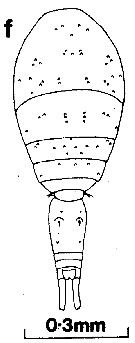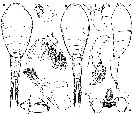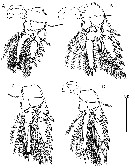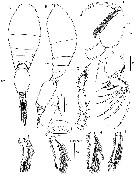|
|
 |
|
Cyclopoida ( Order ) |
|
|
|
Oncaeidae ( Family ) |
|
|
|
Oncaea ( Genus ) |
|
|
| |
Oncaea venella Farran, 1929 (F,M) | |
| | | | | | | Syn.: | Oncaea venusta venella Farran, 1929 (p.210, 284, fig.F); Sewell, 1947 (p.263, Rem. F); 1951 (p.371, Rem.: parasites); Tanaka, 1960 (p.72, Rem., small form); Neto & Paiva, 1966 (p.30, Table III, annual cycle); Corral Estrada, 1970 (p.217); Marques, 1973 (p.247); 1975 (p.51); 1976 (p.1001); Boxshall, 1977 a (p.127, fig.11f, Rem.); Vaissière & Séguin, 1980 (p.23, tab.2); Marques, 1982 (p.772); Vives, 1982 (p.295); Malt, 1983 (p.454, fig.F, Rem.); 1983 a (p.5,7, fig.F, Rem.); Böttger-Schnack & al., 1989 (p.1089); Böttger-Schnack, 1994 (p.277); Bersano & Boxshall, 1994 (p.39, Rem.); Böttger-Schnack, 1996 (p.1086); 1995 (p.92); Ohtsuka & al., 1996 a (p.91); Chihara & Murano, 1997 (p.981, Pl.223: F,M); Boxshall, 1998 (p.227); Böttger-Schnack, 2001 (p.37, 46, 53, figs.F,M, Rem.); Heron, 2002 (p.149, figs.F,M, tab.5, Rem.: p.154); Böttger-Schnack & Huys, 2004 (p.2 & suiv.: Rem.); Böttger-Schnack & al., 2004 (p.1130, tab.1, Rem.); Choi & al., 2005 (p.710: Tab.III); Prusova & Smith, 2005 (p.76, 78); McKinnon & al., 2008 (p.844: Tab.1); Wi & al., 2008 (p.187, figs.F,M, Rem.); Böttger-Schnack & Schnack, 2009 (p.131, Table 3); Böttger-Schnack & Schnack, 2009 (p.131, Table 3, 4, Rem.); Selifonova, 2011 a (p.77, Table 1, alien species in Black Sea); Uysal & Shmeleva, 2012 (p.909, Table I) | | | | Ref.: | | | Böttger-Schnack & al., 2001 (p.1029, tab.1, 2); Elvers & al., 2006 (p.504, 505, 511: Rem.); Wi & al., 2008 (p.187, figs.F,M, Rem.); Vives & Shmeleva, 2010 (p.311 Rem.);
Böttger-Schnack & Schnack, 2013 (p. 8, Table 2: Rem.) ; Fuentes-Reinés & Suarez-Morales, 2017 (p.516, Rem.) |  issued from : G.A. Boxshall in Brit. Mus. nat. Hist., Zool., 1977, 31 (3). [p.125, Fig.11, f]. As Oncaea venusta forma venella. Female (from 18°N, 25°W): f, habitus (dorsal)
|
 issued from : G.A. Heron in Hydrobiologia, 2002, 480. [p.149, Fig.3]. Female: a-b, c, habitus (dorsal and lateral, respectively; scale bar: u); d, anterior of prosome (ventral; scale bar: x); e, right A2 (scale bar: x); f, labrum (ventral; scale bar: y); g, right Md (scale bar: y); h, left Mx1 (scale bar: y); i, right Mx2 (scale bar: y); j, right Mxp (scale bar: w).
|
 issued from : G.A. Heron in Hydrobiologia, 2002, 480. [p.146, Fig.1]. Scale bars = 0.05 mm.
|
 issued from : G.A. Heron in Hydrobiologia, 2002, 480. [p.150, Fig.4]. Female: a-d, P1 to P4 (scale bar: w); e, P5 (scale bar: z). Male: f-g, habitus (dorsal and lateral, respectively; scale bar: v); h, 3rd segment of left A2 (scale bar: x); i, left Mxp (scale bar: w); j, P5 (scale bar: w).
|
 issued from : G.A. Heron in Hydrobiologia, 2002, 480. [p.153, Fig.6]. Female pediger 2-4 and urosome (scale bar: v): a, Oncaea venusta; b, O. frosti; c, O. venella. Nota: O. venella is the smallest of the three species. O. venella is almost identical to O. frosti, except for the less conspicuous body cuticular ornamentation, pediger 2 without a conspicuous mid-dorsal dilation, and the smaller size; the prosome is usually more slender than that of O. frosti, and the female caudal ramus is usually longer than the sum of the preceding three segments; urosome flexed less often than that of O. venusta, but the two postgenital segments and anal segment frequently telescoped.
|
 issued from : J.H. Wi, H.-L Suh, H.S. Yang & H.Y. Soh in Ocean Sci. J., 2008, 43 (4). [p.189, Fig.4]. Female (from Yellow Sea, Korea waters): A-B, habitus (lateral and dorsal, respectively); C, A1; D, A2; E, Md; F, Mx1; G, Mx2; H, Mxp.
|
 issued from : J.H. Wi, H.-L Suh, H.S. Yang & H.Y. Soh in Ocean Sci. J., 2008, 43 (4). [p.190, Fig.5]. Female: A-D, P1 to P4.
|
 issued from : J.H. Wi, H.-L Suh, H.S. Yang & H.Y. Soh in Ocean Sci. J., 2008, 43 (4). [p.191, Fig.6]. Male: A-B, habitus (dorsal and lateral, respectively); C, A1; D, A2; E, Mxp; F-I, endopods of P1 to P4, respectively; J, P5; K, P6.
| | | | | Compl. Ref.: | | | Selifonova & al., 2008 (p.305, Table 2); Böttger-Schnack & Schnack, 2009 (p.131, Table 3); Gubanova & al., 2013 (in press, p.4, Table 2) | | | | NZ: | 10 | | |
|
Distribution map of Oncaea venella by geographical zones
|
| | | | | | | | | | | | | Loc: | | | Angola, Brazil (Rio de Janeiro), S Cape Verde Is., off Morocco-Mauritania, Medit. (Balearic Basin, Tyrrhenian Sea, Strait of Sicily, Ionian Sea, Lebanon Basin, Black Sea), G. of Aqaba, Red Sea (N-S), Arabian Sea, Seychelles Is., Australia (North West Cape), Baja California, Panama (Pacif.), E Korea | | | | N: | 26 (provably more because imperfect determination withO. venusta) | | | | Lg.: | | | (11) F: 0,91-0,85; (35) F: 1,07-0,92; (139) F: ± 0,98; (180) F: 0,95-0,87; (248) F: 0,92-0,85; M: 0,63-0,58; (332) F: 0,95-0,9; M: 0,73-0,67; (336) F: 1,09-0,81; M: 0,91-0,61; (651) F: 1,02-0,82; M: 0,84-0,61; (788) F: 0,88-0,75; M: 0,65-0,55; 0,73; (819) F: 0,75-0,88; (833) F: 0,94-0,86; M: 0,65-0,62; (1020) F: 0,80-0,83; M: 0,56-63; (1047) F: 0,85; {F: 0,75-1,09; M: 0,55-0,91} | | | | Rem.: | Farran (1929) characterises this variety by its dimensions. Tanaka (1960, p.72) observed in his material a small form (0/90-1.00 mm) corresponding to the venella form. The proportional lengths of the anterior and posterior regions of the body female are as 60 to 40. The anterior region about 1.6 times as long as broad (61 : 39), this is more slender than in forma typica (= O. venusta. The posterior region has the segments in the proportional lengths 10 : 45 : 7 : 7 : 9 : 22 = 100. The caudal rami 4 times as long as broad. No structural differences were observed between the two forms venusta and venella.
Heron (2002) considers this variety as a true species (after essentially its dimensions and some minor morphological details), and distinguishes it as a new species O. frosti (see remark for this species).
After Heron (2002, p.150) this is the first time that Oncaea venusta var. venella is elevated to the species level. The difference in size specifications has caused some confusion for investigators. The smaller size reported in Farran (1936) is considered the most authentic, since it was based on additional material. Because specimens have been found conforming to Farran’s size range from three different areas, the smaller size for O. venella appears to be confirmed.
Its presence in the eastern Pacific is confirmed; however, Böttger-Schnack & Huys (2004) contest the geographic localisations of this form which is not always validly identified, and even the existence of this species that corresponds only to a simple form.
See remarks in Oncaea venusta.
After Böttger-Schnack & Schnack ( 2013, p. 7, Table 2) the species from Heron (2002) is insufficiently described .
Observed in the ballast waters of ships in San Francisco. | | | Last update : 26/12/2017 | |
| | | | See my comments on the taxonomic status of the form variants of O. venusta given in the database "World Register of Marine Species (WoRMS)". | |
|
|
|
 Any use of this site for a publication will be mentioned with the following reference : Any use of this site for a publication will be mentioned with the following reference :
Razouls C., Desreumaux N., Kouwenberg J. and de Bovée F., 2005-2025. - Biodiversity of Marine Planktonic Copepods (morphology, geographical distribution and biological data). Sorbonne University, CNRS. Available at http://copepodes.obs-banyuls.fr/en [Accessed January 01, 2026] © copyright 2005-2025 Sorbonne University, CNRS
|
|
 |
 |










